A Year of Eating Locally
Air Date: Week of May 4, 2007
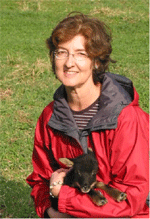
Barbara Kingsolver and a lamb born on her Virginia farm. (Courtesy of Barbara Kingsolver)
Author Barbara Kingsolver recounts her experience of eating locally grown food for a year in the new book “Animal, Vegetable, Miracle: A Year of Food Life.” She tells host Steve Curwood about why food has become a political and environmental issue, about the challenges involved with finding a variety of local food year-round, and how the commitment ultimately changed her family’s life for the better.
Transcript
CURWOOD: Barbara Kingsolver left life in the farm country of Kentucky in the 1970s to become educated as an evolutionary biologist. But what she didn’t know was that she would also become a best-selling novelist. You may know some of her titles: The Poisonwood Bible is one, Prodigal Summer is another. Now she and her husband and daughter have a volume that documents how her family carried out a vow to eat only locally grown food for one year.
The book is called Animal, Vegetable, Miracle; A Year of Food Life. Her family produced about seventy percent of what went on their table from their own farm in Virginia—everything from tomatoes to turkeys. What they couldn’t grow they mostly bought from local farmers. I spoke with Barbara Kingsolver recently. I asked her what motivated her and her family to become what’s known as locavores—people who eat locally.
KINGSOLVER: We were led into this project for so many reasons. For me, It’s because I grew up in a rural community among farmers and I’ve always considered the local farming economy to be important and frankly an important part of food security. We are now, as a nation, putting almost as much fossil fuels into our refrigerators as our cars. Every item on average on the American plate has traveled 1500 miles so add up all the items on your plate and you might as well order room service from the moon!
That’s an incredible amount of fossil fuel, an incredible amount of carbon emissions going into the atmosphere, warming up the globe just to get a grape from Chile, a tomato from Mexico so I can eat a tomato in January.
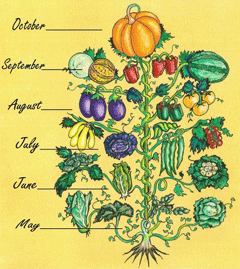
The “vegetannual,” a term invented by Barbara Kingsolver to describe when fruits and vegetables are in season. (Courtesy of Barbara Kingsolver)
KINGSOLVER: I’m so glad you brought that up. US tax payers pay tens of billions of dollars every year to subsidize the production of commodity crops which are, as you mentioned, mostly corn wheat and soybeans. Most of that production enters our diets without our notice as the ingredients of processed foods like high fructose corn syrup and feed to raise cattle and hogs. And we also as taxpayers subsidize the fuel costs of getting these products manufactured and shipped to the market. So it’s a funny thing in this country we think of fast food as cheap in spite of all the fossil fuels and processing that were required to make it while we think of simple unprocessed organic produce as sort of elite, an expensive option. It’s incredibly ironic that the US government urges us to eat more fruits and vegetables but our agricultural programs offer virtually no assistance to fruit and vegetable growers.
CURWOOD: About what did it cost you to grow your own food and buy the rest of it locally?
KINGSOLVER: You know what, we were stunned by the answer to that question. I kept really careful records and I found out that we spent about 50 cents per person per meal to eat as splendidly as we did in this year. And I thought this must be a mistake so I went back and I recalculated and that was it: 50 cents per person per meal.
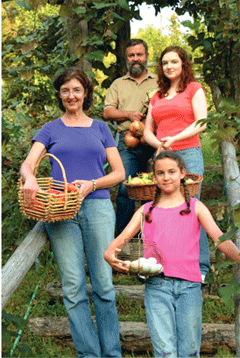
Barbara Kingsolver and family. (Photo: Hank Daniel)
KINGSOLVER: You start by accepting this will be a paradigm shift. This will be a change in the way you think about food and as time went by we really learned to stop asking the question, what do I want right now? and instead start seeing each week as something like the menu in a restaurant Look at what’s available. What do they have? What’s growing this week? What’s fresh and delicious and choose from that.
I do want to point out that we weren’t the strictest locavores. We didn’t for example give up coffee because my husband said, “Coffee will get you through times with no food better than food will get you through times with no coffee.” And I began to understand important things about my marriage.
CURWOOD: Now you were a vegetarian for many years but as part of this project you decided to raise and slaughter your own meat. Talk to me about how and why you came to that decision.
KINGSOLVER: It’s really important to know that food is not just a product but a process. There are two very different ways of producing meat. One of them is concentrated animal feeding operations or CAFOs. These are feed lots for cattle or metal windowless warehouses for hogs, turkeys, chickens and so forth where they’re crowded as close as they possibly can be and these very concentrated populations require that all of their food be milled and processed somewhere else and brought in and then all of the concentrated waste have to be trucked out to somewhere, heaven only knows where. And these animals get fed this porridge of the cheapest ingredients just for the efficiency of producing cheap meat. And also they have to be given antibiotics in order to keep them alive under conditions of extreme physiological stress. So that kind of meat I hadn’t eaten for many years.
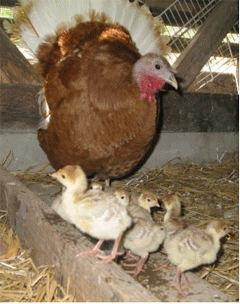
This breeding flock of Bourbon Red turkeys is one of the last remaining flocks in the world.(Courtesy of Barbara Kingsolver)
CURWOOD: Now, there’s a great scene in your book when you’re getting ready to have a party in the early spring. Around this time of year.
KINGSOLVER: That’s right, in May.
CURWOOD: Around your birthday I guess.
KINGSOLVER: Yeah.
CURWOOD: And you’d only been at this a little while. I mean you didn’t have last year’s canned goods or anything stuck in your freezer that you could trot out here.
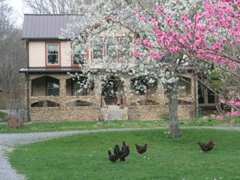
The farmhouse in Virginia. (Courtesy of Barbara Kingsolver)
CURWOOD: Now, where you are in Virginia, you’ve got a farm, a lot of neighbors who are in the food business. But what about somebody who lives in say the city or say a colder climate. What kind of advice would you offer for taking steps to eat more locally?
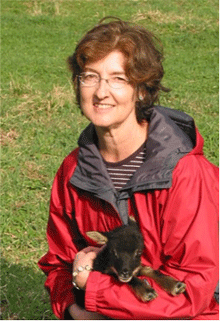
Barbara Kingsolver and a lamb born on her Virginia farm. (Courtesy of Barbara Kingsolver)
CURWOOD: So you eat locally for a year and you lived to tell about it and the day this project was finished did you run out for what uh maybe uh…
KINGSOLVER: Coca Cola and moon pies? No, we didn’t. We forgot to notice the day the project ended. By this time it was just the way we lived. We have a new relationship with where we live. We are what we ate.
CURWOOD: Barbara Kingsolver’s new book is Animal, Vegetable, Miracle; a Year of Food Life. It was written with her husband Steven L. Hopp and daughter Camille Kingsolver. Barbara, thank you so much.
KINGSOLVER: Thank you, bye.
CURWOOD: You can hear more of our conversation with Barbara Kingsolver, as well as readings from the new book and some of her family’s favorite home-grown recipes at our website, loe dot org.
Links
For recipes and a tour of the farm click here
The Farm Bill is up for renewal. Click here for more information
To find community supported agriculture in your area click here
Living on Earth wants to hear from you!
Living on Earth
62 Calef Highway, Suite 212
Lee, NH 03861
Telephone: 617-287-4121
E-mail: comments@loe.org
Newsletter [Click here]
Donate to Living on Earth!
Living on Earth is an independent media program and relies entirely on contributions from listeners and institutions supporting public service. Please donate now to preserve an independent environmental voice.
NewsletterLiving on Earth offers a weekly delivery of the show's rundown to your mailbox. Sign up for our newsletter today!
 Sailors For The Sea: Be the change you want to sea.
Sailors For The Sea: Be the change you want to sea.
 The Grantham Foundation for the Protection of the Environment: Committed to protecting and improving the health of the global environment.
The Grantham Foundation for the Protection of the Environment: Committed to protecting and improving the health of the global environment.
 Contribute to Living on Earth and receive, as our gift to you, an archival print of one of Mark Seth Lender's extraordinary wildlife photographs. Follow the link to see Mark's current collection of photographs.
Contribute to Living on Earth and receive, as our gift to you, an archival print of one of Mark Seth Lender's extraordinary wildlife photographs. Follow the link to see Mark's current collection of photographs.
 Buy a signed copy of Mark Seth Lender's book Smeagull the Seagull & support Living on Earth
Buy a signed copy of Mark Seth Lender's book Smeagull the Seagull & support Living on Earth

